Red weigela, where to buy, how to plant, care features, photos
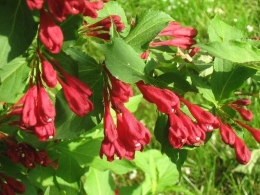
Among the huge number of new varieties, red Weigela occupies an important place. An amazingly elegant and bright plant can become a real pearl of the garden.
However, it is important to remember that caring for this shrub includes a number of features that should not be forgotten.
Content:
- Weigela red: description of the plant
- Varieties and types of weigela, photo of a flowering plant
- Where to buy, how to plant weigela
- Features of care
- Trimming
- Pests and diseases: control and prevention measures
- Weigela after flowering, care and collection of seeds
- Proper organization of wintering, winter-hardy weigela varieties
- Weigela in landscape design
Weigela red: description of the plant
This shrub belongs to the honeysuckle family. It received its name from the famous botanist from Germany Christian von Weigel.
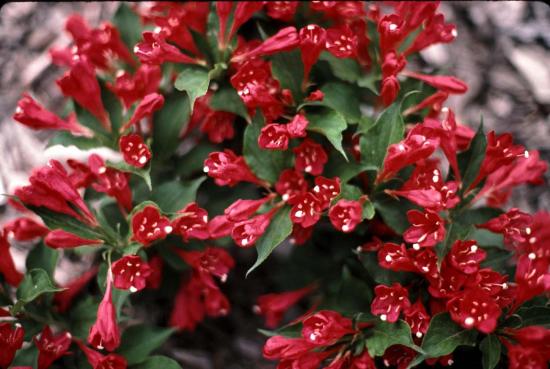
In its natural environment it is found in Southeast Asia. Of the fifteen known species, only seven are used in horticulture.
The plant is unpretentious, loves moisture and grows well in the shade.
Other features include:
- The leaves are arranged oppositely on cuttings without stipules. The edges of the leaf blade are serrated;
- The average length of the buds reaches 5 cm. The flowers are solitary or arranged in loose inflorescences;
- The color of the buds varies from light cream to carmine. At the same time, during flowering the color gradually darkens;
- The fruit is a two-leaf capsule containing small seeds;
- The height may vary depending on the species, but rarely exceeds one and a half meters, although particularly large species can grow up to 3 m.
Coming from warm regions, it does not tolerate winter well, so during frosty winters it is recommended to cover it. The exception is winter-hardy varieties that can withstand a drop in temperature with minimal damage.
Varieties and types of weigela, photo of a flowering plant
Varietal and species diversity allows you to create a wide variety of flower arrangements.
The most common ones include:
- Blooming - came to Europe from Japan. One of the tallest species, can reach 3 m, grows well in shaded areas. Flowering lasts from May to June, the buds are pink. It is important to consider that Blooming does not tolerate stagnation of water, so watering should be moderate;
- Hybrid - characterized by a loose structure of inflorescences, dark pink in color, appear in early spring and last until early summer. Features lush green leaves. Draining of the roots is mandatory in caring for Hybrid to ensure the outflow of excess moisture;
- Bristol Red is a frost-resistant variety with ruby or lilac-pink buds. The height can reach 3 m, it develops especially well in moist, nutrient-rich soils;
- Alexandra is one of the slow-growing representatives, distinguished by the color of its leaves, which ranges from dark green to black. The buds are red or dark pink, develops well with moderate lighting and watering. Despite the fact that it tolerates winter well, it is difficult to classify Alexandra as a frost-resistant variety; in frosty winters it is recommended to cover the shrub;
- Variegated - distinguished by the variegated color of the foliage and the tubular shape of the flower. The buds are colored pink, sometimes in double shades;
- Middendorfa - distinguished by beautiful pale yellow or white flowers that cover the entire bush. It seems that the bush is completely covered with buds;
- Rumba is a rather rare variety that is not easy to find. It is distinguished by small buds of a light pink hue.
When choosing a weigela variety, it is recommended to pay special attention to the characteristics of the plant and study photos; there are plenty of them on the Internet. Despite the external similarity, care may differ, which is worth considering.
For more information about red weigela and other plant varieties, see the video:
Where to buy, how to plant weigela
You can purchase a seedling in a specialized store, or order it online. However, when choosing the second option, it is recommended to use trusted sites. Otherwise, there is a danger of coming across scammers or getting low-quality seedlings.
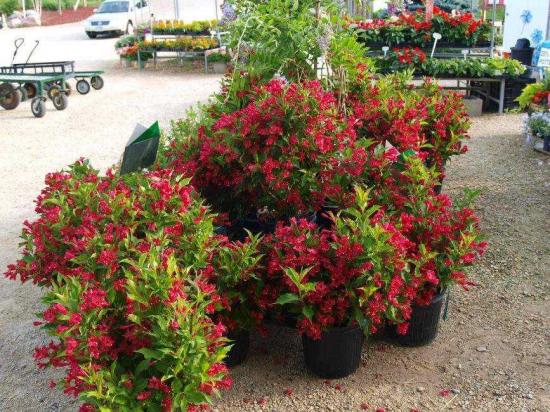
If the seedlings have already been purchased, there is no need to relax. Planting is an important stage that determines the intensity of growth and flowering.
For successful landing it is recommended:
- Choose the right site; the shrub prefers medium illumination, takes root in shaded places, but does not tolerate drafts well. The best option is the southern section, which is located on a slight hill;
- It is recommended to plant in open ground in the spring, after the soil has warmed up sufficiently, but the buds have not yet had time to swell;
- To prepare the soil, a loose substrate rich in humus with a neutral or slightly alkaline reaction is best;
- When preparing holes, it is recommended to take into account the quality of the substrate.If it is rich in nutrients, it is enough to dig a hole up to half a meter deep, but if the soil is poor, you need to dig deeper;
- If the selected variety is large, the distance between the bushes should be at least one and a half meters. For little ones, 80 cm is enough;
- After the hole is ready, place 15 cm of small stones on the bottom for drainage, sprinkle a layer of nitrophoska on top at the rate of 100 g per one and a half buckets of compost;
- Before planting directly, it is recommended to treat the roots of the shrub with a growth stimulator;
- Place the seedlings in the hole, carefully straighten the roots and cover with soil. It is important to ensure that the root collar remains a few centimeters above the soil. After the ground subsides, it will lower and become equal to the ground level;
- After planting, water thoroughly and sprinkle the soil with mulch. Repeat watering for four days.
After planting, it is important to systematically water the young seedlings. If the summer turns out to be hot, watering should be plentiful.
Features of care
Weigela care not as complicated as it might seem at first. It is enough to adhere to a number of simple rules and not to forget about some species characteristics of plants.
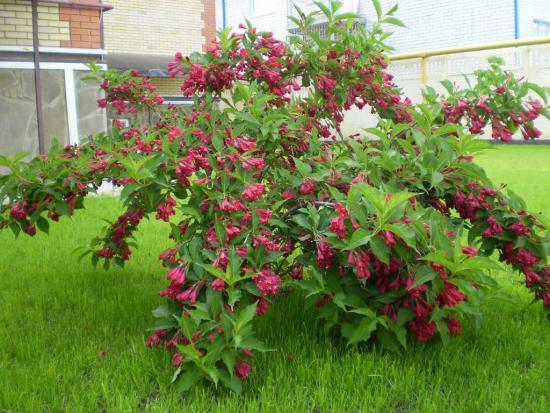
So care includes:
- Systematic watering, which must be moderate. Water stagnation should not be allowed, as this can lead to rotting of the roots. If the winter was not snowy, in the spring it is recommended to pour 10 liters of water under each bush. During summer droughts, it is recommended to water the plants weekly, a bucket for each;
- After watering, it is important not to forget to loosen the soil, removing weeds that clog the bush. This must be done with caution so as not to damage the root;
- Systematic pruning of damaged and unnecessary branches;
- Fertilizer application.After nitrophoska and compost have been added with planting, you can forget about fertilizing for several years, and only in the third year in the spring it is recommended to apply fertilizer. To do this, you can use a mixture of urea - 20 g, potassium salt and superphosphate - 10 g per square meter. The second feeding will be beneficial during the budding period (3 g of superphosphate for each bush). This will ensure abundant flowering and tillering. It is recommended to apply the third fertilizing in the fall, 200 g of wood ash per square meter.
If you follow these simple rules, weigela will delight you with lush and long-lasting flowering. In addition, proper care increases the resistance of the plant, which means there will be much fewer problems with it.
Trimming
Since it is a shrubby plant, systematic pruning is necessary. Thus, young bushes need sanitary cutting of broken, cold-damaged or simply unnecessary branches.
Older shrubs, in addition to sanitary ones, also need formative pruning. To do this, after the flowering period has passed, you need to trim the bush. It is important to have time to prune before the formation of new shoots, on which new buds will later form. Otherwise, there is no point in waiting for re-blooming this summer.
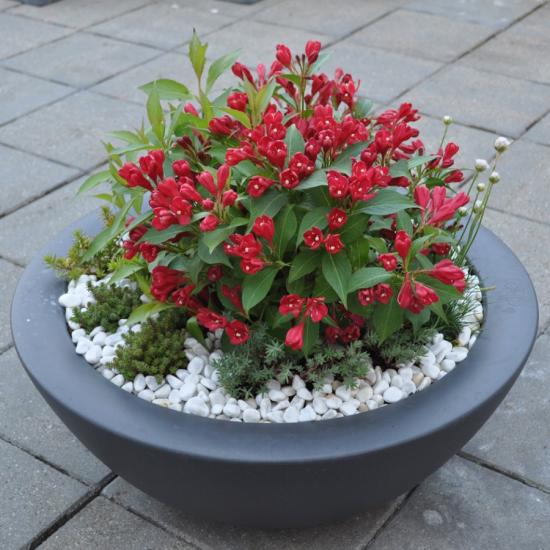
In addition to sanitary and shaping, there is also anti-aging pruning. It is recommended to carry it out once every three years, removing old branches and shortening the rest by a third.
Systematic pruning of the bush will prevent the development of diseases in the bark of old branches. In some cases, complete pruning of the shoots will be useful. There is no need to worry, the weigela is renewed quickly after such a radical haircut.
Pruning will not take much time, but, carried out annually, will show significant results, delighting with lush flowering and active growth.
Pests and diseases: control and prevention measures
Although this is a fairly resilient plant, it can be attacked by pests or suffer from disease. You can tell that something is wrong with the bush by the leaves that begin to fall off and become covered with a white coating or purple or brown spots.
The most common problems include:
- Attacks of aphids and mealybugs, which can be controlled with an insecticide, or an infusion of hot pepper, potato tops;
- A mixture of lime and copper sulfate, Topsin, will help against spotting on the leaves;
- The wilting of seedlings is often caused by the larvae of the cockchafer or mole crickets that got into the hole along with the compost. Actara or karbofos, which you need to water the seedling, can get rid of this problem;
- Root cancer is the most dangerous disease that cannot be cured. The disease can be identified by the formation of round swellings on the roots. When this disease develops, it is recommended to dig up the affected bush to protect others. It is not worth planting a healthy weigela in the same place, since in the first few years the soil will harbor the disease.
In prevention, systematic pruning of old branches and mechanical inspection of bushes will be effective. A problem noticed in time is the first step to success, since in the initial stages it is much easier to cope with defeat.
Weigela after flowering, care and collection of seeds
The seeds ripen at the beginning of autumn, but there is no need to rush into collection; it is carried out only in October, after the bolls begin to crack.In September, to prevent the seeds from spilling on the ground, it is recommended to carefully wrap the boxes in gauze so that the “bundle” is cut off afterwards.
Remove the gauze from the cut box and pour the resulting seeds onto paper to dry. After the excess moisture has evaporated, they need to be placed in a paper bag, on which you must write down the variety and set the time of assembly. It is recommended to store packaged planting material in a dry, dark place until spring.
It is important to consider that the seeds remain viable for several years. At the same time, plants grown from seeds often lose the distinctive features of the mother bush.
Proper organization of wintering, winter-hardy weigela varieties
Properly organized wintering is the key to ensuring that the shrub will withstand the winter cold with minimal damage. After the leaves fall, it is recommended to fill the tree trunk circle with soil to a height of up to 20 cm. The branches need to be bent to the ground and secured, covering the top of the bush with roofing material. The coating should also be secured so that it does not come off.
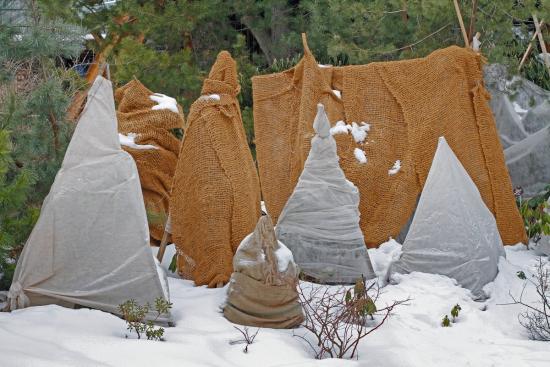
Despite the fact that weigela is initially a fairly heat-loving plant that does not tolerate cold weather well, there are several representatives that are distinguished by relative frost resistance.
| Early | Came to European territory from the Far East. It is distinguished by violet-scarlet or lilac-pinkish funnel-shaped buds collected in inflorescences. The average height reaches several meters, the leaves are pubescent. |
| Middendorf | In the natural environment, it is distributed in Japan, Sakhalin and China. The branches of the bush are compact, the average height varies from a meter to one and a half. The buds are large, up to 4 cm in diameter. |
| Blooming | Originally from China and Korea, it withstands cold weather, reaches a height of 3 m. It has beautiful flowering, the color of the buds can be white or dark scarlet. |
If there are no winter-hardy representatives in the garden, and you don’t want to lose the plant, you should take care of covering the bush.
Another interesting feature of weigela is the fact that frostbitten branches are very quickly replaced by new ones and the damage is almost invisible.
We invite you to watch an interesting video about the features of caring for weigela:
Weigela in landscape design
Lush foliage and abundant flowering could not go unnoticed by landscape design specialists. Weigela has long been firmly established in many garden compositions.
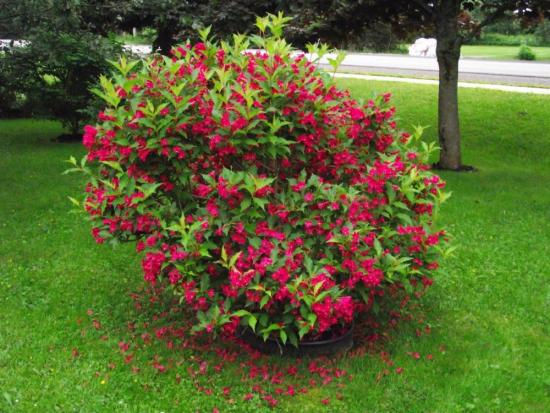
So, it is often used:
- To create a bright hedge that is easy to shape and looks quite impressive while maintaining the distance between neighboring bushes;
- On alpine hills, where low-growing varieties look great, adding color and airiness;
- When forming compositions, the bushes look impressive in combination with junipers and barberries. Suitable for growing in shaded areas under trees;
- On mixborders, where varieties with a compact crown combine perfectly with spring flowers;
- Single planting, which looks especially impressive against the background of the lawn.
Lush flowering plant could not go unnoticed by specialists and amateurs. Varietal diversity provides a unique opportunity to create something completely unique.
Weigela is a beautiful plant, recognized by gardeners due to its abundant flowering, variety of varieties and lush bushes that are easy to form.Unpretentious and persistent, it requires minimal effort in care, the result of which will not be long in coming.

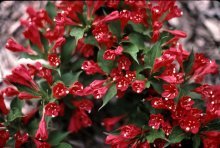
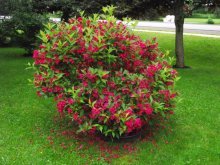

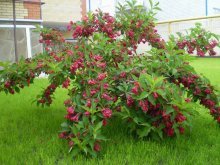
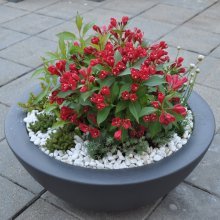
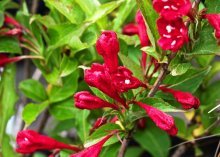
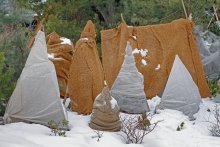
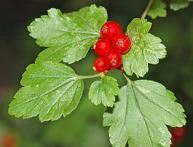
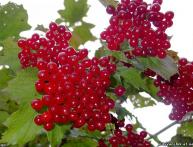
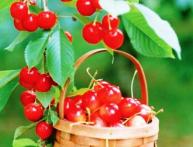

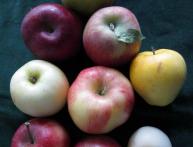
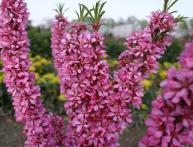
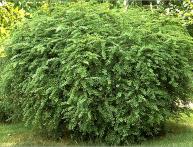
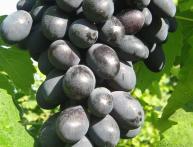
Comments
It is a beautiful shrub, but there is a lot of care to take care of it so that it grows and is healthy and beautiful; besides, for the winter it is necessary to cover the plant with leaves and wrap each bush well.
A very beautiful plant, we have this shrub growing in our front garden. We do not wrap the shrubs for the winter, because our winters are quite warm. We do not do pruning to form a bush, but remove dried and broken branches.